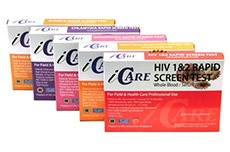Table of Contents
Objective
This article examines how non-governmental organizations (NGOs) operating across Saint Lucia utilize HIV test kits, including HIV rapid screen tests, HIV self-test kits and HIV home test kits, to facilitate mobile outreach. The article explores technical deployment, community engagement, logistical execution and region-specific strategies that support widespread HIV testing throughout the island.
What is mobile HIV screening and how do HIV test kits facilitate it?
Mobile HIV screening refers to the decentralized delivery of HIV testing services outside traditional clinic settings. NGOs use HIV rapid test kits, which include HIV serum rapid screen tests, HIV saliva rapid screen tests and HIV self-test kits, to bring diagnostic tools directly into communities.
This approach allows individuals in remote or underserved areas to access screening services at markets, community centers, public gatherings and even at their own homes. A rapid HIV test kit typically delivers results within 15-20 minutes, allowing for immediate counseling or referral. These test kits can detect antibodies using a small blood sample or oral fluid, depending on the type, making them versatile for field conditions.
Why is mobile HIV testing critical for outreach in Saint Lucia?
Saint Lucia’s topography includes mountainous terrain, scattered villages and limited transportation infrastructure, which can make access to health services difficult in districts like Choiseul, Micoud or Anse La Raye. In such settings, the use of HIV home test kits or HIV serum rapid tests is vital to reach populations with low testing rates.
NGOs deploy HIV testing kits through mobile vans, temporary booths or door-to-door campaigns. In places like Castries, where urban density and population turnover are high, outreach is structured around workplaces and transit hubs. Meanwhile, in Soufrière, which sees a mix of locals and transient workers, outreach must accommodate different work hours and accessibility constraints.

How do NGOs choose which HIV test kits to use in mobile outreach?
The choice of HIV rapid test kits depends on several factors: population characteristics, climate conditions, storage logistics and ease of use. Common types include:
- HIV serum rapid screen test: A blood-based test that can provide reliable results within minutes; widely used in structured outreach setups.
- HIV saliva test: A non-invasive option for individuals unwilling to provide a blood sample; ideal for youth and first-time testers.
- HIV self-test kit: Provided for individuals who prefer to test in privacy at their own pace; NGOs may follow up with phone-based support.
Each HIV testing kit must be transportable, shelf-stable and interpretable in the field. NGOs often carry multiple types to offer testing choices and maximize acceptance.

How is mobile testing managed in cities like Castries, Vieux Fort and Gros Islet?
In Castries, the capital, mobile HIV screening often takes place in high-traffic zones such as bus terminals, marketplaces and public squares. NGOs may use both HIV quick test kits and HIV saliva rapid screen tests to quickly test individuals during work breaks or while they’re commuting.
In Vieux Fort, a southern commercial hub, outreach teams visit labor-heavy areas like the industrial zone and fishery docks. Here, workers are offered HIV self-test kits to use after hours, with optional on-site assistance.
Gros Islet, known for its nightlife and tourism, presents a unique setting where NGOs conduct nighttime testing using HIV rapid home test kits and mobile booths at events and bars. The approach here emphasizes discretion, cultural sensitivity and trust-building.
How do NGOs maintain accuracy and safety with rapid HIV test kits during field use?
Reliability is paramount during mobile outreach. To ensure accurate use of HIV test kits, NGOs adhere to the following protocols:
- Maintain temperature control using insulated carriers during transportation.
- Use pre-validated rapid test kit HIV batches and cross-check with control samples.
- Train outreach workers in sample collection (e.g., finger-prick for blood tests) and in interpreting results accurately.
- Follow strict biohazard disposal protocols to prevent contamination and maintain community trust.
Outreach staff may also carry logbooks to record anonymized data for follow-up and referral tracking.
How are HIV-positive cases handled during mobile testing in Saint Lucia?
When a mobile HIV rapid screen test yields a reactive result, NGOs follow a pre-set protocol to ensure the client receives confirmatory testing and care:
- Immediate post-test counseling is offered to explain results and next steps.
- The individual is referred to the nearest clinic for a confirmatory HIV serum rapid test.
- Transport support may be provided for follow-up visits.
- A linkage officer may follow up confidentially to ensure continuity of care.
In mobile campaigns using HIV self-test kits, participants are given clear instructions and helpline contact details for result interpretation and next steps if they test positive.
How do NGOs engage communities before deploying HIV testing kits?

Before launching mobile screening, NGOs conduct sensitization activities. These include:
- Town hall meetings in Micoud or Canaries to introduce the initiative.
- Collaboration with local leaders or churches to endorse testing.
- Posters, radio announcements and community groups to promote events.
Engagement helps demystify the process and reduce stigma. In areas like Dennery, where misinformation may circulate, the visibility of trained staff using HIV testing kits in a professional and friendly manner helps shift perceptions and increase participation.
What logistical challenges do NGOs face in deploying HIV test kits in mobile settings?
Despite their utility, the field deployment of rapid HIV test kits involves challenges such as:
- Difficult terrain or poor roads, especially in Banse La Grace or Fond St. Jacques.
- High humidity affecting the shelf life of HIV saliva test kits.
- Electricity shortages preventing refrigeration in extended campaigns.
- Unpredictable weather interrupting outdoor events.
- Limited mobile data coverage, affecting digital reporting or consultation.
To manage these, NGOs use solar-powered fridges, route planning software and manual data recording as backup. Staff are trained to handle unexpected disruptions while maintaining professional conduct.
How is testing data collected and used in NGO mobile programs?
Mobile outreach involves both clinical and administrative tracking. For each individual tested using an HIV test kit, anonymized data are collected, including:
- Date and location of testing
- Type of test kit HIV used
- Result (non-reactive or reactive)
- Follow-up or referral status
This data helps NGOs map coverage gaps and plan future outreach. In cities like Laborie and Babonneau, repeat visits are scheduled based on community interest and previous turnout. Patterns may also guide the distribution of HIV home test kits in areas where in-person turnout is low.

What practices ensure long-term sustainability of mobile HIV screening?
To maintain momentum, NGOs focus on:
- Regular staff training on emerging test technologies like new-generation HIV rapid test kits.
- Community ownership, by training locals to assist with coordination.
- Partnering with local health agencies for resource sharing.
- Continuous procurement of quality HIV testing kits with validated performance.
- Monitoring the return rate and outcome of distributed HIV self-test kits.
By building institutional memory and community trust, NGOs ensure that mobile testing becomes a reliable fixture in Saint Lucia’s public health response.
Conclusion
Mobile HIV testing in Saint Lucia, led by NGOs, represents a highly adaptable model tailored to the island’s geographical and social landscape. With careful deployment of various HIV test kits – including rapid HIV test kits, HIV saliva rapid screen tests and HIV self-test kits – these organizations bridge the gap between diagnostic services and communities.
From the bustling streets of Castries to the remote hills of Choiseul and the coastal fringes of Vieux Fort, mobile HIV outreach has become an essential strategy in expanding awareness, reducing stigma and identifying undiagnosed cases. By maintaining quality control, logistical planning and community trust, NGOs continue to strengthen HIV response across the nation.
FAQs About HIV Rapid Test Kits
What types of HIV test kits are used in mobile outreach?
Blood-based rapid HIV test kits, saliva-based tests and self-test kits are commonly used, depending on the setting and target group.
Can people test themselves at home with kits provided by NGOs?
Yes. HIV self-test kits are often distributed during outreach for private home use, with support offered via phone or in-person follow-up.
What happens if someone tests positive during mobile screening?
The person receives immediate counseling and is referred for confirmatory testing and follow-up care.
How do NGOs ensure test accuracy during mobile outreach?
Through training, quality control procedures, correct sample handling and safe disposal methods.
Which regions in Saint Lucia are commonly included in mobile outreach?
Castries, Vieux Fort, Soufrière, Gros Islet, Micoud, Choiseul and other semi-urban and rural areas are regularly covered.






